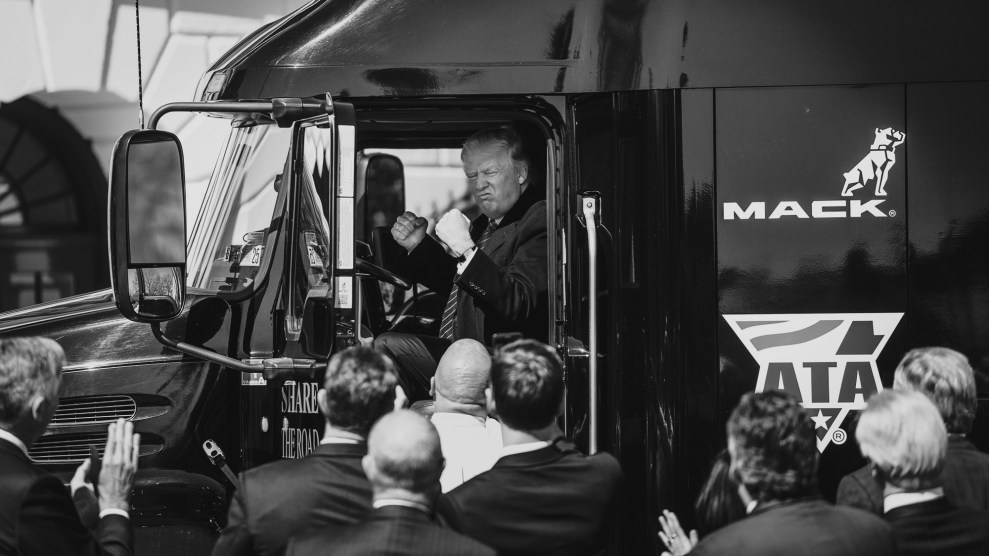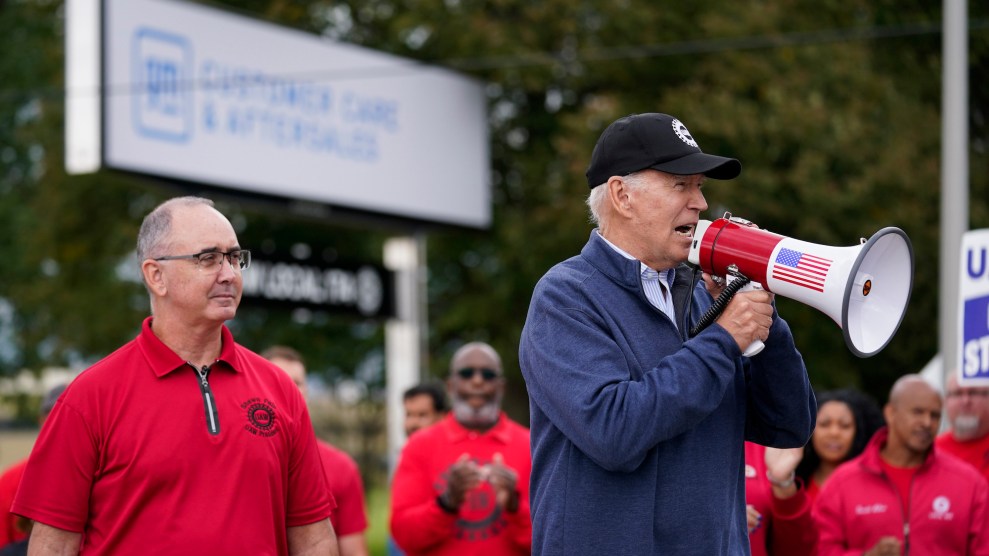
Melina Mara/The Washington Post/Getty
In early 2017, the Chamber of Commerce published the top 10 policies it wanted to see change under Donald Trump at the National Labor Relations Board. Trump’s appointees, along with the Supreme Court majority he secured, took action on all 10: Bosses got more power to bust unions, workers were forced into mandatory arbitration, and others saw their ability to organize curtailed.
These are some of the facts Trump almost certainly won’t mention when he speaks in Michigan on Wednesday night. The speech, which coincides with the ongoing UAW strike and the Republican debate he is skipping, was initially billed as an address to current former and union members. Along the way, it often got reported as a speech to striking autoworkers.
It is certainly not that, even if some UAW members end up in the audience. Unlike President Joe Biden, who became the first sitting president in US history to visit a picket line on Tuesday, Trump is headed to Drake Enterprises, an auto parts company outside Detroit whose workers are not affiliated with the UAW or any other union. He is appearing with the approval of management, and the company’s non-union workers have been invited to attend. They will likely hear a fantastical story that ignores the many ways his administration consistently undermined the rights of unionized workers.
UAW President Shawn Fain, who has been highly critical of Trump, said on CNN on Tuesday that “I find a pathetic irony that the former president is going to hold a rally for union members at a nonunion business.”
“The ultimate show of how much he cares about our workers was in 2019, when he was the president of the United States,” Fain added. “Where was he then? Our workers at GM were on strike for two months…I didn’t see him hold a rally. I didn’t see him stand up at the picket line.”
On CNN @UAW president Shawn Fain was asked about Donald Trump. He said:
"I don't think the man has any bit of care about what our workers stand for, what the working class stands for.
He serves a billionaire class and that's what's wrong with this country." pic.twitter.com/gOC4SDZfSn
— More Perfect Union (@MorePerfectUS) September 27, 2023
Autoworkers at the Big Three can only win a strong contract by staying united. Trump does not care about that; his goal is to try to get votes by dividing the union’s membership and making a hollow case for why he is pro-worker. He has said that autoworkers “are being sold down the river by their leadership,” claimed that UAW leaders have “got some deals going for themselves,” and told rank-and-file workers not to pay the union dues that replenish the strike fund. It is the same kind of rhetoric workers hear from union-busting consultants hired by management. (Jennfier Abruzzo, Biden’s general counsel at the National Labor Relations Board, supports banning those captive-audience meetings.)
Trump’s reductive pitch to autoworkers is: “I WILL KEEP YOUR JOBS AND MAKE YOU RICH!!!” His stated agenda is to abandon the Biden administration’s push for electric vehicles, which he argues will “automatically” be made in China. Instead, he will push for the United States to keep making gas-powered cars. (As I’ve written, while there are real concerns about whether the EV transition will undermine union jobs, Trump’s rhetoric does not make sense.)
What matters more, though, is what Trump actually did as president. It’s worth mentioning some positives first. Trump, no fan of austerity, wanted interest rates low and the stock market booming. That helped create a tight labor market that gave workers leverage. His antipathy to free trade helped push Democrats away from the neoliberalism of Bill Clinton and Barack Obama, and toward the industrial policy of the Biden era.
At the same time, in typical GOP fashion, he pushed through a massive tax cut that overwhelmingly favored the wealthiest Americans. Barry Eidlin, a labor expert and sociology professor at McGill University, describes Trump’s labor record as “regular Republican terrible” when compared to other parts of his presidency.
Trump’s initial choice to run the Department of Labor was Andy Puzder, a fast food executive critical of the Affordable Care Act and minimum-wage increases. Puzder withdrew from consideration after, among other things, a tape of his ex-wife accusing him of abuse on the Oprah Winfrey Show in 1990 began circulating. (She later said he was not abusive.)
His pick for deputy labor secretary, Patrick Pizzella, did get confirmed. As I reported at the time, Pizzella had worked with Jack Abramoff to promote sweatshops in the Northern Mariana Islands. According to a 1998 government report, the clothing factories relied heavily on “indentured alien workers” from Asia who were often subjected to abusive conditions. Nevertheless, the garments they made were stamped “Made in the USA” and sent to the mainland tariff-free.
Trump’s first labor secretary, Alexander Acosta, resigned amid allegations that he gave Jeffrey Epstein too lenient a plea deal while at the Justice Department. Trump replaced him with Eugene Scalia, who, like his late father, Supreme Court Justice Antonin Scalia, was dedicated to eliminating policies that safeguard workers.
At the National Labor Relations Board, Trump favored corporate attorneys who’d represented management in disputes with workers. As general counsel, he picked Peter Robb, a longtime management-side lawyer who had once helped Ronald Reagan fire more than 11,000 striking air traffic controllers in a move that signaled open season on organized labor.
Justice Neil Gorsuch, Trump’s pick to replace Antonin Scalia on the Supreme Court, provided the decisive vote in major cases limiting workers’ rights. He joined a 5-4 majority that ruled that companies could force their workers into individual arbitration hearings that heavily favor their employers. In another, he joined the majority in effectively nationalizing right-to-work in the public sector by ruling that government workers cannot be forced to pay union fees.
If Biden simply had turned out to be a standard Democrat, it would have been a major improvement for workers over the Trump years. But he has gone well beyond that. Nelson Lichtenstein, a labor historian who leads the Center for the Study of Work, Labor, and Democracy at the University of California–Santa Barbara, said via email that he considers the shift from Jimmy Carter to Reagan the most dramatic anti-union turn between presidential administrations. “The Trump-Biden switch is certainly the equal of that in the opposite direction,” he added. (Eidlin agrees with Lichtenstein, but cautioned that Biden’s frequently quoted pledge to be the “most pro-union” president means less given the recent competition.)
On his first day in office, Biden broke with precedent by firing Robb and later replaced him with Abruzzo, a longtime NLRB veteran who has worked to not only undo Trump-era decisions but significantly expand labor rights beyond where they were under past Democratic administrations. Eidlin says the decision to bring on Abruzzo is probably “the single most consequential thing” Biden has done. (The editorial board at the Wall Street Journal, whose Biden-era headlines include “The NLRB’s Union Assault on Amazon” and “Starbucks Sees Pro-Union Bias at the NLRB,” seems to agree.)
Along with that and other personnel changes, Liechtenstein notes that Biden has kept unemployment low by continuing to favor stimulus over austerity. He adds that Biden’s pivot toward industrial-policy programs that promote battery factories, semiconductor fabrication plants, and new infrastructure will help unions indirectly, while raising wages in the Midwest and mid-South.
America’s unionization rate remains low—dropping from 10.3 percent to 10.1 percent last year. But there are signs that workers have noticed that they now have people in the administration who will stand behind them. As the Washington Post has reported, union elections jumped by 53 percent between the 2021 and 2022 fiscal years. The increase comes after the NLRB has moved aggressively to force companies to rehire workers who are illegally fired for supporting union drives.
None of this is to say Biden has a perfect record when it comes to supporting labor. He angered many union members by stepping in to block a rail strike, and his administration initially frustrated autoworkers with how little it did to promote fair wages at the new battery plants. But there is no question that he has broken with both Trump and recent Democrats.
There is another thing Trump is unlikely to say on Wednesday: His second term likely wouldn’t be any different for workers than his first. Through its Project 2025 program, the Heritage Foundation has already laid out what Trump’s labor agenda would likely look like if he returns to the White House. The plan was written by Jonathan Berry, a former clerk to Justice Samuel Alito who led the Labor Department’s regulatory office under Trump. He portrays the actions of Biden’s NLRB as uniformly bad—hiding the old hostility to labor behind a haze of anti-woke, pro-Judeo-Christian rhetoric. It might be time for the autoworkers Trump is speaking to tonight to form a union.
















